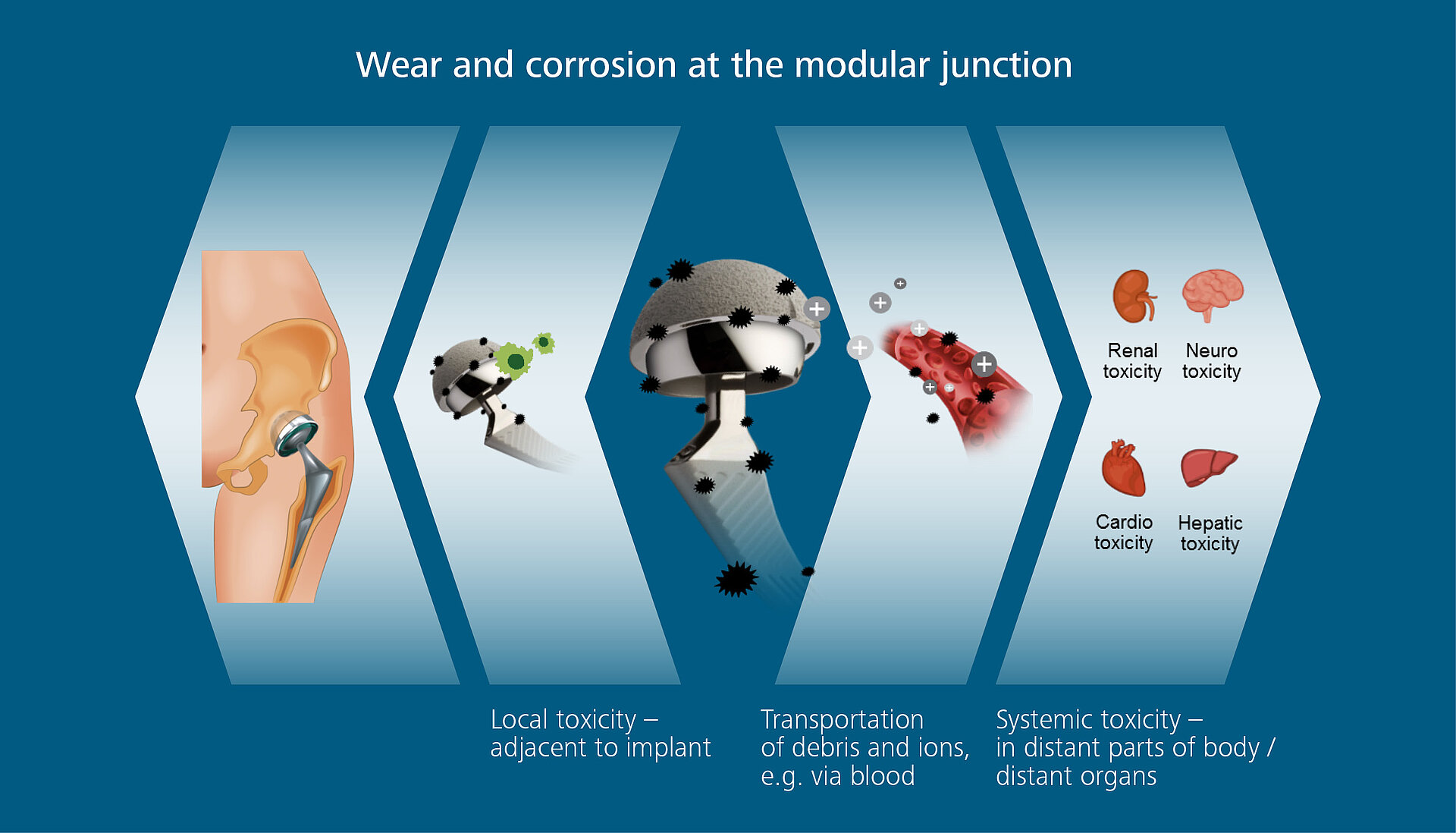Particle induced cardiotoxicity
An association between THA metal bearings and cardiotoxicity has been observed by several groups. In their investigations, Wyles et al. (2017) and Swiatkotwska et al. (2018) found out that heart failures were associated with exposure of metal ions and raised concerns about the toxicity of metal bearings.
Associations between cobalt depositions in the cardiac tissue and cardiac fibrosis and cardiomegaly were demonstrated by Wyles et al. They found a moderate correlation between cardiac cobalt levels and cumulative implant years. Moreover, higher cobalt levels were measured in patients that underwent revision surgery or in patients that had a hip replacement combined with a total knee or shoulder replacement. The authors suggest an association between the accumulation of metal toxins generated by CoCr implant components in a distant organ and systemic long-term complications on the patients. This research work can serve as the basis for further studies investigating the safety of CoCr components used in orthopaedic clinical practice.
Before, Swiatkotwska et al. found that potentially harmful metal species may disseminate into human organs of arthroplasty patients with metal bearings. The authors discovered through histological and elemental analyses an accumulation of wear debris and corrosion products in distant organs (i.e. heart, liver, spleen, etc.) collected post mortem from patients with metal-on-polyethylene hip implants.
The authors exploited a systematic approach employing optical microscopy, laser ablation inductively coupled plasma mass spectrometry, micro-X-ray fluorescence and micro-X-ray absorption spectroscopy. The combination of these methods allowed to assess the distribution and chemical nature of implant debris found in organ tissue samples.
The major finding of the study was that carcinogenic forms of chromium might arise in vital organs of THA patients. The hexavalent oxidation state of chromium (CrVI) is the most harmful state, however it is very unlikely that CrVI species originate directly from the implant. Instead, the re-oxidation of trivalent chromium (CrIII) released by metal bearings to carcinogenic CrVI species may be possible. Under pathological, but also normal conditions cells may generate oxidants. It follows that the oxidation of trivalent chromium to its carcinogenic valence state may be promoted by elevated levels of biological oxidants in the blood.
The presence of cobalt in tissues from MoP patients resulted to be only mildly elevated, although several patients showed cardiomegaly or severe interstitial fibrosis.
Interestingly, titanium oxide was also found within the tissue samples, nevertheless it could have originated from other external sources as it is commonly used in food and personal care products, as well as being present in ambient air.
These findings with limited evidence were confirmed recently by a large epidemiological study performed by Lassalle et al. (2018). The analysis of the French Health Authorities ANSM database (255.350 hip patients) revealed a higher risk for heart failure and cardiomyopathy in patients with metal bearings compared to patients with ceramic bearings. A further increased risk has been identified for women and older patients (≥ 75 years).
The authors recommend to monitor regularly the cardiac function in patients with metallic bearings.
CeramTec is committed to selecting and bringing to interested parties relevant articles on bioceramics related topics. The presented authors’ views and opinions are solely those of the authors of these publications. It is the focus and intent of CeraNews that CeramTec presents and comments on the authors’ views and opinions in a specific context. Such comments and editorials therefore solely express CeramTec’s views and opinions and not necessarily those of the quoted authors.
References
Swiatkowska I. et al. (2018) Synchrotron analysis of human organ tissue exposed to implant material. J Trace Elem Med Biol. 46: 128–137.
Man K. et al., (2017), Immunological response to total hip arthroplasty, J. Funct. Biomater., 8(3).
Wyles CC et al. (2017) Myocardial cobalt levels are elevated in the setting of total hip arthroplasty. J Bone Joint Surg Am. 99:e118.
Dahms K et al. Cobalt intoxication diagnosed with the help of Dr House. Lancet. 2014 Feb 8;383(9916):574. doi: 10.1016/S0140-6736(14)60037-4.


